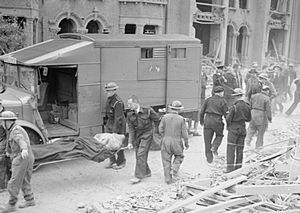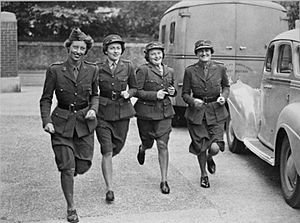American Ambulance Great Britain facts for kids
| Founded | 1940 |
|---|---|
| Focus | Humanitarian |
|
Area served
|
United Kingdom |
| Method | Emergency casualty transport |

The American Ambulance, Great Britain (AAGB) was a special group started in 1940. It was created by Americans living in London during World War II. Their main goal was to provide emergency vehicles and ambulance teams to the United Kingdom. This was a huge help during the war.
The idea for this service came from Gilbert H. Carr. He thought of it during a meeting in London, right after the Dunkirk evacuation. This was when many soldiers were rescued from France.
People gave money to help the AAGB. Americans living in the UK and people in the United States all donated. Wallace B. Phillips led the group. Even Joseph P. Kennedy Sr., who was the US Ambassador at the time, was an honorary chairman. They raised a lot of money very quickly. By the end of 1940, they had raised over $850,000!
The AAGB eventually had about 300 vehicles helping people.
Contents
How the AAGB Helped
The American Ambulance, Great Britain, had 17 stations across Britain. Five of these were in London. Other stations were in big cities like Cardiff, Cambridge, Birmingham, and Edinburgh. This helped them cover a wide area.
Their main office was in London for most of the war. It was at 9 Grosvenor Gardens.
Brave People Who Helped
About 400 British women worked as ambulance staff. They were usually between 18 and 45 years old. Some of these women came from other transport groups like the Mechanised Transport Corps.
The AAGB members wore a special uniform. It looked like the uniform of the Women's Transport Services (FANY). But they had a unique patch on their sleeve. It showed crossed British and American flags. All their training happened in Leeds.
Sadly, some brave members of the AAGB lost their lives helping others during the war.
- Marjorie Stewart Butler was one of these heroes. She was helping people after a huge German air raid in London in May 1941. Part of a damaged building collapsed on her. She later died from her injuries.
- Dorothy Helen Daly was another brave driver. She was killed in May 1942 when her house was bombed during the Exeter Blitz.
These women showed incredible courage while helping people in dangerous times.
Their Amazing Vehicles

All the AAGB vehicles were painted grey. They had a red stripe and a special emblem with British and American flags. The AAGB used different types of vehicles for different jobs:
- Ambulances were used to go to bombing sites. They took injured people to hospitals and first aid stations. They also moved patients who needed special care over long distances. They used different models like the Austin K2/Y and Chevrolet Ambulances.
- Mobile First-Aid Posts were special vans. They were designed to drive through roads full of rubble after air raids. These units could treat hundreds of injured people. They also had trucks with doctors, nurses, and people to carry stretchers.
- Surgical Units were cars assigned to hospitals. They were meant to take medical teams to bomb sites. But they were often used to move injured people instead. These were usually large American cars.
The money to keep these vehicles running came from donations. The British War Relief Society of America helped manage these funds.
Gallery of AAGB photographs
-
A patient being placed in an ambulance at Guy's Hospital, London. An AAGB member can be seen on the left, 1941.
-
A police officer has his hand bandaged at the rear of an AAGB Austin K2/Y following a V1 attack in Upper Norwood, 1944.
See also
- American Ambulance Field Service
- Hadfield-Spears Ambulance Unit
- British War Relief Society
- Friends' Ambulance Unit







